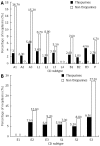Thiopurines related malignancies in inflammatory bowel disease: local experience in Granada, Spain
- PMID: 23946592
- PMCID: PMC3740417
- DOI: 10.3748/wjg.v19.i30.4877
Thiopurines related malignancies in inflammatory bowel disease: local experience in Granada, Spain
Abstract
Aim: To investigate the incidence of neoplasms in inflammatory bowel disease (IBD) patients and the potential causative role of thiopurines.
Methods: We performed an observational descriptive study comparing the incidence of malignancies in IBD patients treated with thiopurines and patients not treated with these drugs. We included 812 patients which were divided in two groups depending on whether they have received thiopurines or not. We have studied basal characteristics of both groups (age when the disease was diagnosed, sex, type of IBD, etc.) and treatments received (Azathioprine, mercaptopurine, infliximab, adalimumab or other immunomodulators), as well as neoplasms incidence. Univariate analysis was performed with the student t test, χ(2) test or Wilcoxon exact test as appropriate. A logistic regression analysis was performed as multivariate analysis. Statistical significance was establish at P values of less than 0.05, and 95%CI were used for the odds ratios.
Results: Among 812 patients included, 429 (52.83%) have received thiopurines: 79.5% azathioprine, 14% mercaptopurine and 6.5% both drugs. 44.76% of patients treated with thiopurines and 46, 48% of patients who did not receive this treatment were women (P > 0.05). The proportion of ulcerative colitis patients treated with thiopurines was 30.3% compare to 66. 67% of patients not treated (P < 0.001). Mean azathioprine dose was 123.79 ± 36.5 mg/d (range: 50-250 mg/d), mean usage time was 72.16 ± 55.7 mo (range: 1-300 mo) and the accumulated dose along this time was 274.32 ± 233.5 g (1.5-1350 g). With respect to mercaptopurine, mean dose was 74.7 ± 23.9 mg/d (range: 25-150 mg/d), mean usage time of 23.37 ± 27.6 mo (range: 1-118 mo), and the accumulated dose along this time was 52.2 ± 63.5 g (range: 1.5-243 g). Thiopurine S-methyltransferase activity was tested in 66% of patients treated with thiopurines, among which 98.2% had an intermediate or high activity. Among the patients treated with thiopurines, 27.27% (112 patients) and 11.66% (50 patients) received treatment with Infliximab and Adalimumab respectively, but only 1.83% (7 patients) and 0.78% (3 patients) received these drugs in the group of patients who did not received thiopurines (P < 0.001 and P < 0.001 respectively). Finally, 6.8% (29 patients) among those treated with thiopurines have received other immunosuppressants (Methotrexate, Tacrolimus, Cyclosporin), compare to 1% (4 patients) of patients not treated with thiopurines (P < 0.001). Among patients treated with thiopurines, 3.97% developed a malignancy, and among those not treated neoplasms presented in 8.1% (P = 0.013). The most frequent neoplasms were colorectal ones (12 cases in patients not treated with thiopurines but none in treated, P < 0.001) followed by non-melanoma skin cancer (8 patients in treated with thiopurines and 6 in not treated, P > 0.05).
Conclusion: In our experience, thiopurine therapy did not increase malignancies development in IBD patients, and was an effective and safe treatment for these diseases.
Keywords: Azathioprine; Crohn’s disease; Inflammatory bowel disease; Malignancy; Mercaptopurine; Neoplasm; Thiopurines; Ulcerative colitis.
Figures



Similar articles
-
Use of thiopurines in the treatment of inflammatory bowel disease is associated with an increased risk of non-melanoma skin cancer in an at-risk population: a cohort study.J Gastroenterol Hepatol. 2012 Feb;27(2):385-9. doi: 10.1111/j.1440-1746.2011.06865.x. J Gastroenterol Hepatol. 2012. PMID: 21793904
-
NUDT15 R139C causes thiopurine-induced early severe hair loss and leukopenia in Japanese patients with IBD.Pharmacogenomics J. 2016 Jun;16(3):280-5. doi: 10.1038/tpj.2015.43. Epub 2015 Jun 16. Pharmacogenomics J. 2016. PMID: 26076924
-
Risk of malignancies in patients with inflammatory bowel disease treated with thiopurines or anti-TNF alpha antibodies.Pharmacoepidemiol Drug Saf. 2014 Jul;23(7):735-44. doi: 10.1002/pds.3621. Epub 2014 Apr 30. Pharmacoepidemiol Drug Saf. 2014. PMID: 24788825
-
Thiopurine therapy in inflammatory bowel disease.Expert Rev Gastroenterol Hepatol. 2010 Oct;4(5):575-88. doi: 10.1586/egh.10.59. Expert Rev Gastroenterol Hepatol. 2010. PMID: 20932143 Review.
-
Appropriateness of immunosuppressive drugs in inflammatory bowel diseases assessed by RAND method: Italian Group for IBD (IG-IBD) position statement.Dig Liver Dis. 2005 Jun;37(6):407-17. doi: 10.1016/j.dld.2004.12.013. Dig Liver Dis. 2005. PMID: 15893279 Review.
Cited by
-
Solid extraintestinal malignancies in patients with inflammatory bowel disease.World J Gastrointest Oncol. 2021 Dec 15;13(12):1956-1980. doi: 10.4251/wjgo.v13.i12.1956. World J Gastrointest Oncol. 2021. PMID: 35070035 Free PMC article. Review.
-
Systematic review: treatment pattern and clinical effectiveness and safety of pharmaceutical therapies for Crohn's disease in Europe.Clin Exp Gastroenterol. 2016 Oct 5;9:311-323. doi: 10.2147/CEG.S109696. eCollection 2016. Clin Exp Gastroenterol. 2016. PMID: 27785086 Free PMC article. Review.
-
The Treatment of Inflammatory Bowel Disease in Patients With a History of Malignancy.Inflamm Bowel Dis. 2019 May 4;25(6):998-1005. doi: 10.1093/ibd/izy376. Inflamm Bowel Dis. 2019. PMID: 30590558 Free PMC article. Review.
-
Oral Conventional Synthetic Disease-Modifying Antirheumatic Drugs with Antineoplastic Potential: a Review.Dermatol Ther (Heidelb). 2022 Apr;12(4):835-860. doi: 10.1007/s13555-022-00713-1. Epub 2022 Apr 5. Dermatol Ther (Heidelb). 2022. PMID: 35381976 Free PMC article. Review.
-
Use of thiopurines and risk of colorectal neoplasia in patients with inflammatory bowel diseases: a meta-analysis.PLoS One. 2013 Nov 28;8(11):e81487. doi: 10.1371/journal.pone.0081487. eCollection 2013. PLoS One. 2013. PMID: 24312308 Free PMC article.
References
-
- Smith MA, Irving PM, Marinaki AM, Sanderson JD. Review article: malignancy on thiopurine treatment with special reference to inflammatory bowel disease. Aliment Pharmacol Ther. 2010;32:119–130. - PubMed
-
- Karran P. Thiopurines, DNA damage, DNA repair and therapy-related cancer. Br Med Bull. 2006;79-80:153–170. - PubMed
-
- Ling YH, Chan JY, Beattie KL, Nelson JA. Consequences of 6-thioguanine incorporation into DNA on polymerase, ligase, and endonuclease reactions. Mol Pharmacol. 1992;42:802–807. - PubMed
-
- Somerville L, Krynetski EY, Krynetskaia NF, Beger RD, Zhang W, Marhefka CA, Evans WE, Kriwacki RW. Structure and dynamics of thioguanine-modified duplex DNA. J Biol Chem. 2003;278:1005–1011. - PubMed
-
- Tidd DM, Paterson AR. A biochemical mechanism for the delayed cytotoxic reaction of 6-mercaptopurine. Cancer Res. 1974;34:738–746. - PubMed
Publication types
MeSH terms
Substances
LinkOut - more resources
Full Text Sources
Other Literature Sources

